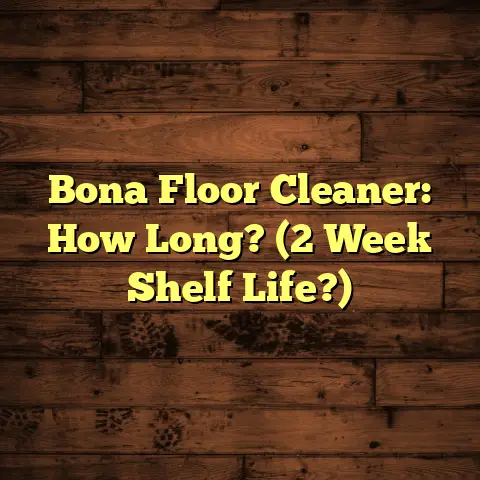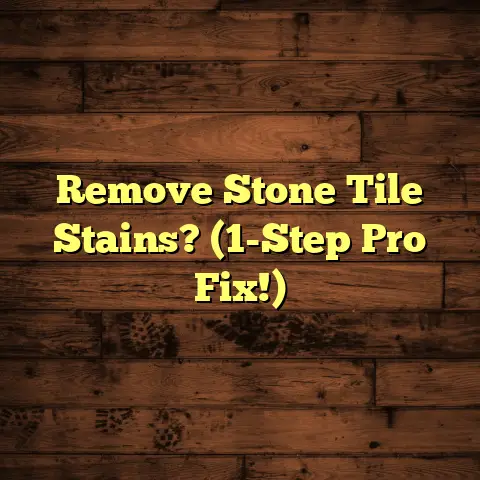Stained Concrete Floor Life? (5 Year Warning!)
If you are looking for a low-maintenance flooring option that delivers aesthetic appeal and durability, stained concrete floors could be your perfect solution!
I’m talking about stained concrete floors.
They’re versatile, easy to care for, and can give your space a unique, modern look.
But before you jump in, let’s talk about something important: how long do they really last?
I’ve seen a lot of stained concrete floors in my time as a flooring contractor, and I want to give you the real deal.
Section 1: Understanding Stained Concrete Floors
1.1 Definition and Composition
So, what exactly are stained concrete floors?
Basically, it’s regular concrete that’s been treated with a stain to add color and visual interest.
Unlike other flooring options that are installed on top of a subfloor, stained concrete is the floor.
It’s concrete that’s been transformed.
The process usually involves:
-
Concrete: This is the foundation, of course!
It needs to be properly prepped and often requires a smooth, even surface.
-
Stain: This is where the magic happens.
The stain reacts with the concrete to create a permanent color.
-
Sealer: This is the protective layer that keeps the stain looking good and prevents damage.
Think of it like this: concrete is the canvas, the stain is the paint, and the sealer is the varnish.
1.2 Types of Stains
There are two main types of concrete stains: acid-based and water-based.
Here’s the lowdown:
-
Acid-Based Stains: These stains react chemically with the concrete, creating a mottled, variegated look.
They penetrate deeply, making the color very durable.
But they can be a bit trickier to work with due to their corrosive nature.
-
Water-Based Stains: These stains are more like paints that sit on the surface of the concrete.
They offer a wider range of colors and are easier to apply.
However, they might not be as durable as acid-based stains.
Which one is better?
It depends on the look you’re going for and your tolerance for a more complex application process.
I’ve used both and each has their pros and cons.
1.3 Popular Applications of Stained Concrete
Stained concrete is popping up everywhere!
Here are some common places you’ll find it:
-
Residential Homes: Basements, living rooms, kitchens, and bathrooms.
It’s a great way to add a modern touch.
-
Commercial Spaces: Retail stores, restaurants, offices.
It’s durable enough to handle heavy foot traffic.
-
Outdoor Areas: Patios, walkways, pool decks.
It can withstand the elements (with the right sealer, of course).
Design-wise, stained concrete can complement a variety of styles, from industrial and minimalist to modern and even rustic.
I’ve seen it paired with everything from exposed brick to sleek, modern furniture.
Section 2: Longevity of Stained Concrete Floors
2.1 Expected Lifespan
Okay, let’s get to the million-dollar question: how long will your stained concrete floor actually last?
A well-maintained stained concrete floor can last for decades.
I’m talking 20, 30 years, or even longer!
But that comes with caveats.
Compared to other flooring materials:
-
Hardwood: Can last a lifetime with proper care, but is susceptible to water damage and scratches.
-
Tile: Very durable and can last for decades, but can be cold and hard underfoot.
-
Laminate: Less expensive, but also less durable and typically needs to be replaced every 10-15 years.
Stained concrete offers a good balance of durability and cost-effectiveness, if you take care of it.
2.2 Factors Affecting Durability
So, what can shorten the lifespan of your stained concrete floor?
Here are some key factors:
-
Environmental Conditions: Extreme temperatures, moisture, and UV exposure can all take a toll.
-
Foot Traffic: High-traffic areas will wear down faster than low-traffic areas.
-
Maintenance Practices: Neglecting regular cleaning and resealing can significantly reduce the lifespan.
-
Quality of Installation: A poorly installed floor is more likely to crack and develop problems.
I always tell my clients that proper prep and a good sealer are crucial for longevity.
2.3 The 5-Year Warning
Now, let’s talk about the “5-Year Warning.”
I’ve noticed that around the 5-year mark, many stained concrete floors start to show signs of wear and tear.
This isn’t to say your floor will suddenly fall apart after five years!
But it’s a critical time to assess the floor’s condition and take proactive measures.
Why five years?
-
Sealer Breakdown: Most sealers start to degrade after a few years, leaving the stain vulnerable.
-
Cumulative Wear: The effects of foot traffic, cleaning, and environmental exposure start to become more noticeable.
-
Early Warning Signs: Cracks, fading, and other issues may start to appear, indicating underlying problems.
Think of it as a check-up for your floor.
It’s a chance to catch small problems before they become big, expensive headaches.
Section 3: Signs of Wear and Tear in Stained Concrete Floors
3.1 Common Issues
What are some of the problems you might encounter after five years?
Here are a few common ones I’ve seen:
-
Fading: The color of the stain starts to fade, especially in areas exposed to sunlight.
-
Chipping: Small chips and flakes appear on the surface, often in high-traffic areas.
-
Cracking: Cracks can develop due to settling, temperature changes, or impact.
-
Moisture Issues: Water can seep through the concrete, causing discoloration and damage.
UV exposure is a big one!
I’ve seen floors near large windows fade dramatically in just a few years.
3.2 Visual Indicators
How can you tell if your stained concrete floor is showing its age?
Here are some visual cues to look for:
-
Dullness: The floor loses its shine and appears dull, even after cleaning.
-
Scratches: Scratches and scuff marks become more noticeable.
-
Stains: Stains from spills and other accidents become harder to remove.
-
Efflorescence: A white, powdery substance appears on the surface, indicating moisture issues.
Take a close look at your floor, especially in areas that get a lot of use.
Do you see any of these signs?
If so, it’s time to take action.
Here are some descriptions of common damage types:
-
Hairline Cracks: Thin, barely visible cracks that don’t affect the structural integrity of the floor.
-
Spider Cracks: A network of small, interconnected cracks that resemble a spiderweb.
-
Impact Cracks: Larger cracks caused by heavy objects or impacts.
3.3 Structural Concerns
Sometimes, the problem isn’t just cosmetic.
Underlying issues with the concrete itself can also cause problems.
These might include:
-
Settling: The concrete slab shifts or settles, causing cracks and unevenness.
-
Moisture Intrusion: Water seeps through the foundation, damaging the concrete and causing mold growth.
-
Poor Installation: Improperly mixed or poured concrete can be weak and prone to cracking.
If you suspect a structural problem, it’s important to consult with a professional engineer or concrete specialist.
Ignoring these issues can lead to more serious and expensive repairs down the road.
Section 4: Maintenance Practices for Stained Concrete Floors
4.1 Regular Cleaning
The best way to keep your stained concrete floor looking good is to clean it regularly.
Here are some tips:
-
Sweep or vacuum regularly: Remove dirt, dust, and debris to prevent scratching.
-
Mop with a neutral cleaner: Avoid harsh chemicals or abrasive cleaners that can damage the sealer.
-
Clean up spills immediately: Don’t let spills sit on the surface, as they can stain.
I recommend using a pH-neutral cleaner specifically designed for concrete floors.
Avoid anything acidic, like vinegar or lemon juice.
4.2 Sealing and Resealing
Sealing is crucial for protecting your stained concrete floor.
The sealer acts as a barrier against moisture, stains, and wear.
-
Initial Sealing: Apply a high-quality sealer after the stain has been applied and cured.
-
Resealing: Reseal the floor every 1-3 years, depending on traffic and wear.
Here’s a step-by-step guide on how to properly seal stained concrete floors:
- Clean the floor thoroughly: Remove all dirt, dust, and debris.
- Etch the surface (optional): This helps the sealer adhere better.
- Apply the sealer: Use a roller or sprayer to apply a thin, even coat.
- Let it dry: Allow the sealer to dry completely according to the manufacturer’s instructions.
- Apply a second coat (optional): This provides extra protection.
I always recommend using a high-quality sealer designed for concrete floors.
Don’t skimp on this step!
4.3 Addressing Minor Repairs
Even with the best care, minor damage can still occur.
Here are some tips on how to handle minor repairs:
-
Filling Cracks: Use a concrete crack filler to fill in small cracks.
-
Touch-Up Staining: Use a matching stain to touch up faded or damaged areas.
-
Applying a New Coat of Sealer: This can help to protect the floor and prevent further damage.
For larger repairs, it’s best to consult with a professional.
Trying to fix a major crack or structural problem yourself can make things worse.
Section 5: Future-Proofing Your Stained Concrete Floors
5.1 Upgrading Techniques
Want to take your stained concrete floor to the next level?
Here are some advanced techniques to consider:
-
Polishing: Polishing the concrete creates a smooth, shiny surface that’s very durable.
-
Decorative Overlays: Adding a decorative overlay can create a unique, textured look.
-
Epoxy Coatings: Applying an epoxy coating provides a tough, chemical-resistant surface.
I’ve seen some amazing polished concrete floors that look like marble!
It’s a great way to add a touch of luxury.
5.2 Choosing the Right Products
Selecting the right stains and sealers is crucial for extending the life of your stained concrete floor.
Here are some tips:
-
Choose a high-quality stain: Look for a stain that’s durable and UV-resistant.
-
Select the right sealer: Choose a sealer that’s appropriate for your floor’s use and the type of stain you’re using.
-
Read the labels: Follow the manufacturer’s instructions carefully.
I always recommend doing your research and talking to a professional before choosing products.
5.3 Staying Informed
The world of concrete flooring is constantly evolving.
New products and techniques are always being developed.
Here’s how to stay informed:
-
Read industry publications: Stay up-to-date on the latest trends and technologies.
-
Attend trade shows: See new products and learn from industry experts.
-
Talk to professionals: Get advice from experienced flooring contractors.
Staying informed will help you make the best decisions for your stained concrete floor.
Conclusion
So, there you have it: the real deal on stained concrete floor life.
While stained concrete floors offer a fantastic blend of style and durability, it’s crucial to understand their potential lifespan and the factors that can affect it.
Remember that “5-Year Warning”?
It’s a reminder to assess your floor’s condition and take proactive measures to prevent problems.
By following these tips and taking good care of your floor, you can ensure that it remains beautiful and functional for years to come.
Proper maintenance, including regular cleaning and resealing, is key to keeping your stained concrete floors looking their best.
Don’t wait until problems arise; be proactive and address any issues as soon as you notice them.
With the right care, your stained concrete floor can be a stunning and long-lasting addition to your home or business.





